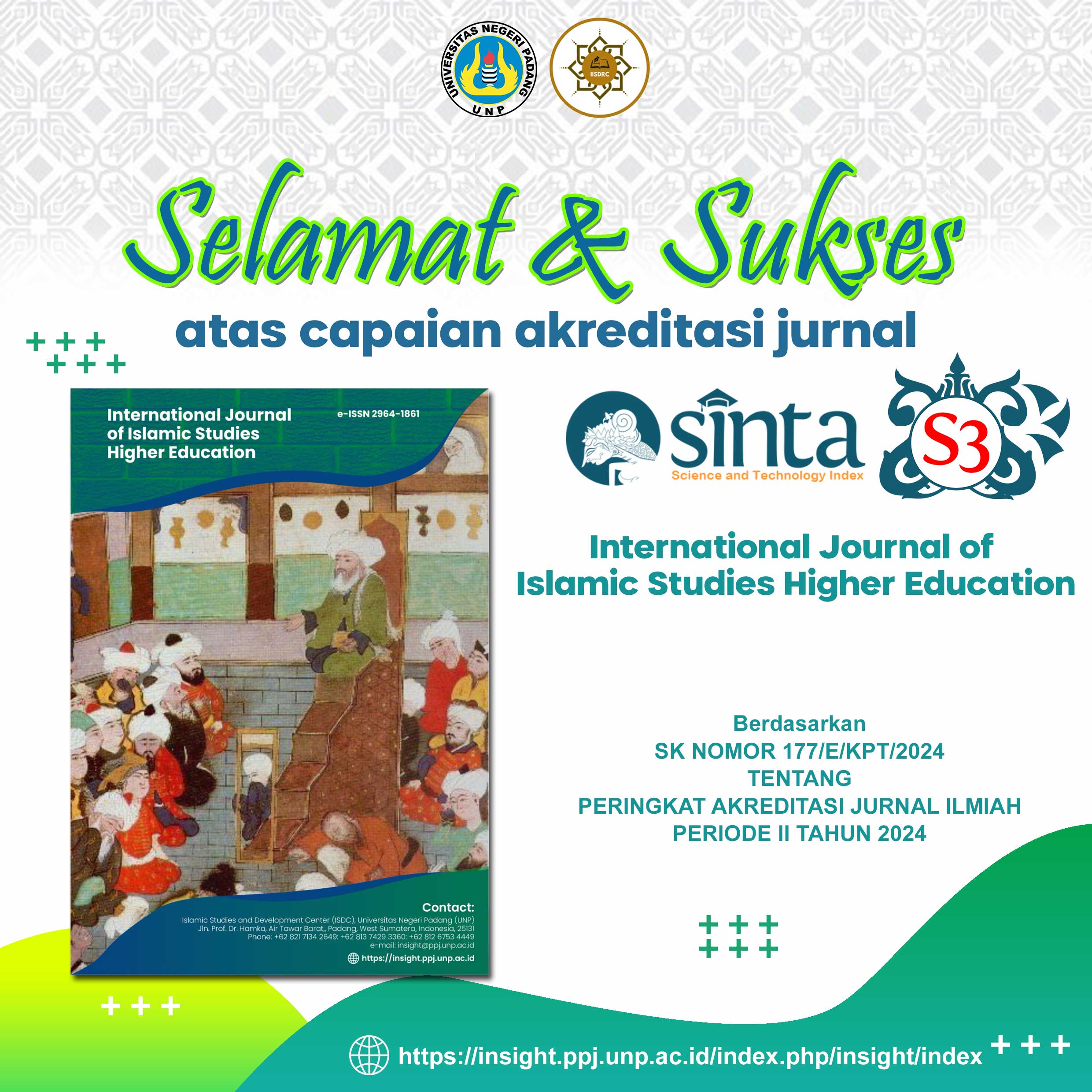Green Campus Management in Islamic Higher Education: Sustainable Development Goals 13
DOI:
https://doi.org/10.24036/insight.v4i1.201Keywords:
Academic community, campus environment, green campus managementAbstract
Universitas Islam Negeri Raden Intan Lampung is committed to advancing green campus management as a proactive response to the challenges of increasing pollution and environmental degradation faced in Indonesia. This research investigates the specific initiatives undertaken by Universitas Islam Negeri Raden Intan Lampung in implementing green campus management. Using a qualitative method with a case study approach, data sources were drawn through in-depth interviews with twenty informants consisting of five university administrators, ten lecturers and students, and five operational staff selected by purposive sampling. To strengthen the results of the interviews, the author also collected data from expert opinions and highly reputable journals related to this research in the same context and issue. All data were analyzed using the Miles and Huberman interactive analysis technique. This research found seven aspects of green campus management at Universitas Islam Negeri Raden Intan Lampung that successfully increase the awareness and participation of the academic community in environmental sustainability. These aspects include i) Institutional Management, ii) Policy and Regulation Management, iii) Education and Curriculum Management, iv) Student Participation Management, v) Reward and Motivation Management, vi) Human Resource Management (Cleaning Staff), vii) Cross-Unit Collaboration Management. This approach forms an environmentally friendly campus culture as a whole.
References
Abubakar, I. R., Al-Shihri, F. S., & Ahmed, S. M. (2016). Students’ assessment of campus sustainability at the University of Dammam, Saudi Arabia. Sustainability (Switzerland), 8(1), 59. https://doi.org/10.3390/su8010059
Anwar, N., Nik Mahmood, N. H., Yusliza, M. Y., Ramayah, T., Noor Faezah, J., & Khalid, W. (2020). Green Human Resource Management for organisational citizenship behaviour towards the environment and environmental performance on a university campus. Journal of Cleaner Production, 256, 120401. https://doi.org/10.1016/j.jclepro.2020.120401
Araújo, I., Nunes, L. J. R., & Curado, A. (2023). Preliminary Approach for the Development of Sustainable University Campuses: A Case Study Based on the Mitigation of Greenhouse Gas Emissions. Sustainability (Switzerland), 15(6), 5518. https://doi.org/10.3390/su15065518
Bishop, L., & Kuula-Lummi, A. (2017). Revisiting qualitative data reuse: A decade on. SAGE Open, 7(1). https://doi.org/10.1177/2158244016685136
Brennen, B. S. (2021). Qualitative Research Methods for Media Studies, Third Edition. In Qualitative Research Methods for Media Studies, Third Edition (pp. 1–256). https://doi.org/10.4324/9781003122388
Chater, A., Family, H., Lim, R., & Courtenay, M. (2020). Influences on antibiotic prescribing by non-medical prescribers for respiratory tract infections: A systematic review using the theoretical domains framework. Journal of Antimicrobial Chemotherapy, 75(12), 3458–3470. https://doi.org/10.1093/jac/dkaa335
Chen, D., Liu, R., & Zhou, M. (2023). Delineation of Urban Growth Boundary Based on Habitat Quality and Carbon Storage: A Case Study of Weiyuan County in Gansu, China. Land, 12(5). https://doi.org/10.3390/land12051006
Clevenger, M. R. (2019). The Complexity of Inter-organizational Relationships: Cross-unit Analysis, Discussion, and Implications. In Corporate Citizenship and Higher Education (pp. 211–240). Springer International Publishing. https://doi.org/10.1007/978-3-030-02447-5_7
Coutts, C., & Hahn, M. (2015). Green Infrastructure, Ecosystem Services, and Human Health. International Journal of Environmental Research and Public Health, 12(8), 9768–9798. https://doi.org/10.3390/ijerph120809768
Effendi, C., & Mardiana, M. (2024). Peran Universitas dalam Mendukung Pencapaian SDGs. Journal of Accounting, Finance, Taxation, and Auditing (JAFTA), 6(1). https://doi.org/10.28932/jafta.v6i1.8695
Engkizar, E., Jaafar, A., Sarianto, D., Ayad, N., Rahman, A., Febriani, A., Oktavia, G., Guspita, R., & Rahman, I. (2024). Analysis of Quran Education Problems in Majority Muslim Countries. International Journal of Islamic Studies Higher Education, 3(1), 65–80. https://doi.org/https://doi.org/10.24036/insight.v3i1.209
Engkizar, Engkizar, Kaputra, S., Mutathahirin, M., Syafril, S., Arifin, Z., & Kamaluddin, M. (2022). Model Pencegahan Konflik Antarumat Beragama Berbasis Kegiatan Masyarakat. Harmoni, 21(1), 110–129. https://doi.org/10.32488/harmoni.v21i1.603
Eriyanti, F., Engkizar, E., Alhadi, Z., Moeis, I., Murniyetti, M., Yulastri, A., & Syafril, S. (2020). The Impact of Government Policies towards the Economy and Education of Fishermen’s Children in Padang City. IOP Conference Series: Earth and Environmental Science, 469(1), 1–7. https://doi.org/10.1088/1755-1315/469/1/012057
Faezah, J. N., Yusliza, M. Y., Azlina, Y. N., Saputra, J., & Wan Zulkifli, W. K. (2022). Developing a Conceptual Model to Implement the Employee Ecological Behavior in Organisations. Journal of Environmental Management and Tourism, 13(3), 746–755. https://doi.org/10.14505/jemt.v13.3(59).14
Fu, L., Zhang, Y., Xiong, X., & Bai, Y. (2018). Pro-environmental awareness and behaviors on campus: Evidence from Tianjin, China. Eurasia Journal of Mathematics, Science and Technology Education, 14(1), 427–445. https://doi.org/10.12973/ejmste/77953
Fua, J., Wekke, I., Sabara, Z., & Nurlila, R. (2018). Development of Environmental Care Attitude of Students through Religion Education Approach in Indonesia. IOP Conference Series: Earth and Environmental Science, 175, 012229. https://doi.org/10.1088/1755-1315/175/1/012229
Hidayati, R. N., & Sodikin, S. (2023). Benefit analysis of the implementation of Environmental Management System (EMS) ISO 14001:2015 in a tyres industry. Indonesian Journal of Applied Environmental Studies, 4(2), 77–84. https://doi.org/10.33751/injast.v4i2.8897
Huddart, J. E. A., Crawford, A. J., Luna-Tapia, A. L., Restrepo, S., & Di Palma, F. (2022). EBP-Colombia and the bioeconomy: Genomics in the service of biodiversity conservation and sustainable development. Proceedings of the National Academy of Sciences of the United States of America, 119(4). https://doi.org/10.1073/pnas.2115641119
Jamilah, N. A., Widodo, M., & Suhendi, E. (2023). Addressing Environmental Concerns: Strategies of Islamic Boarding School Teachers in Promoting Environmental Ethics. International Journal of Nusantara Islam, 11(2), 246–259. https://doi.org/10.15575/ijni.v11i2.30892
Karman, Anwar, R., & Hakim, L. (2023). the Qur’Anic Learning Based on Islamic Eco-Theology At Pesantren. Jurnal Pendidikan Islam, 9(2), 169–186. https://doi.org/10.15575/jpi.v9i2.24933
Kaushika, N. D., Reddy, K. S., & Kaushik, K. (2016). The Environment. In Sustainable Energy and the Environment: A Clean Technology Approach (pp. 17–29). Springer International Publishing. https://doi.org/10.1007/978-3-319-29446-9_2
Kim, J. G., Jeon, J., & Shin, W. S. (2021). The influence of forest activities in a university campus forest on student’s psychological effects. International Journal of Environmental Research and Public Health, 18(5), 1–16. https://doi.org/10.3390/ijerph18052457
Klein, C. (2017). Negotiating Cultural Boundaries Through Collaboration: The Roles of Motivation, Advocacy and Process. Innovative Higher Education, 42(3), 253–267. https://doi.org/10.1007/s10755-016-9382-7
Larson, L. R., Stedman, R. C., Cooper, C. B., & Decker, D. J. (2015). Understanding the multi-dimensional structure of pro-environmental behavior. Journal of Environmental Psychology, 43, 112–124. https://doi.org/10.1016/j.jenvp.2015.06.004
Li, X. Z., Chen, C. C., & Kang, X. (2022). Research on the cultivation of sustainable development ability of higher vocational students by creative thinking teaching method. Frontiers in Psychology, 13. https://doi.org/10.3389/fpsyg.2022.979913
Liu, Q., & Wang, Z. (2022). Green BIM-based study on the green performance of university buildings in northern China. Energy, Sustainability and Society, 12(1).
https://doi.org/10.1186/s13705-022-00341-9
Mahdee, J., Abu Bakar, N., & Oh Kim Seng, V. (2022). Green campus universities: case studies on problems and prospects. F1000Research, 11(1200), 1200. https://doi.org/10.12688/f1000research.73381.1
Molokova, E. (2021). Higher education as a sustainable development tool. E3S Web of Conferences, 291(5040). https://doi.org/10.1051/e3sconf/202129105040
Naik, S. M., Bandi, S., Mahajan, H., Waiker, D., & Gadhia, D. (2021). A study on infusing and expanding clean and green learning spaces on campus. Journal of Engineering Education Transformations, 34(Special Issue), 257–262. https://doi.org/10.16920/jeet/2021/v34i0/157152
Pandikar, E., Affandi, I., Disman, D., & Sundawa, D. (2024). Harmonizing Economic Principles, Islamic Values, and Entrepreneurial Attitudes for a Sustainable Environment. Yupa: Historical Studies Journal, 6(2), 188–197. https://doi.org/10.30872/yupa.v6i2.3739
Pandya, C., Prajapati, S., & Gupta, R. (2022). Sustainable Energy Efficient Green Campuses: A Systematic Literature Review and Bibliometric Analysis. IOP Conference Series: Earth and Environmental Science, 1084(1), 12016. https://doi.org/10.1088/1755-1315/1084/1/012016
Patil, G. N., Tanavade, S. S., Sudhir, C. V., & Saravanan, A. M. (2023). Strategic Energy Management and Carbon Footprint Reduction in University Campuses: A Comprehensive Review. International Journal of Energy Economics and Policy, 13(6), 15–27. https://doi.org/10.32479/ijeep.14873
Plummer, R., Baird, J., & Dale, G. (2022). What Makes an Environmental Steward? An Individual Differences Approach. Environmental Values, 31(3), 295–322. https://doi.org/10.3197/096327121X16141642287773
Ragheb, A., El-Shimy, H., & Ragheb, G. (2016). Green Architecture: A Concept of Sustainability. Procedia - Social and Behavioral Sciences, 216, 778–787. https://doi.org/10.1016/j.sbspro.2015.12.075
Rahman, N. A., & Jalil, M. H. (2021). Awareness of the Role of “Religious People” in Environmental Conservation from the Perspective of Islamic Studies Students. Creative Education, 12(08), 1755–1772. https://doi.org/10.4236/ce.2021.128133
Reo, N. J., Whyte, K. P., McGregor, D., Smith, M. A. (Peggy., & Jenkins, J. F. (2017). Factors that support Indigenous involvement in multi-actor environmental stewardship. AlterNative, 13(2), 58–68. https://doi.org/10.1177/1177180117701028
Sachs, J. D., Schmidt-Traub, G., Mazzucato, M., Messner, D., Nakicenovic, N., & Rockström, J. (2019). Six Transformations to achieve the Sustainable Development Goals. Nature Sustainability, 2(9), 805–814. https://doi.org/10.1038/s41893-019-0352-9
Salvia, A. L., Leal Filho, W., Brandli, L. L., & Griebeler, J. S. (2019). Assessing research trends related to Sustainable Development Goals: local and global issues. Journal of Cleaner Production, 208, 841–849. https://doi.org/10.1016/j.jclepro.2018.09.242
Satrial, A., Febrianto, F., Zulmasri, Z., Nurhayati, N., & Engkizar, E. (2025). Designing the character profile of Pancasila through Islamic personal development activities in the late childhood phase. Primary: Jurnal Pendidikan Guru Sekolah Dasar, 13(3), 136–145. https://doi.org/10.33578/jpfkip-v13i3.p136-145
Abubakar, I. R., Al-Shihri, F. S., & Ahmed, S. M. (2016). Students’ assessment of campus sustainability at the University of Dammam, Saudi Arabia. Sustainability (Switzerland), 8(1), 59. https://doi.org/10.3390/su8010059
Anwar, N., Nik Mahmood, N. H., Yusliza, M. Y., Ramayah, T., Noor Faezah, J., & Khalid, W. (2020). Green Human Resource Management for organisational citizenship behaviour towards the environment and environmental performance on a university campus. Journal of Cleaner Production, 256, 120401. https://doi.org/10.1016/j.jclepro.2020.120401
Araújo, I., Nunes, L. J. R., & Curado, A. (2023). Preliminary Approach for the Development of Sustainable University Campuses: A Case Study Based on the Mitigation of Greenhouse Gas Emissions. Sustainability (Switzerland), 15(6), 5518. https://doi.org/10.3390/su15065518
Bishop, L., & Kuula-Lummi, A. (2017). Revisiting qualitative data reuse: A decade on. SAGE Open, 7(1). https://doi.org/10.1177/2158244016685136
Brennen, B. S. (2021). Qualitative Research Methods for Media Studies, Third Edition. In Qualitative Research Methods for Media Studies, Third Edition (pp. 1–256). https://doi.org/10.4324/9781003122388
Chater, A., Family, H., Lim, R., & Courtenay, M. (2020). Influences on antibiotic prescribing by non-medical prescribers for respiratory tract infections: A systematic review using the theoretical domains framework. Journal of Antimicrobial Chemotherapy, 75(12), 3458–3470. https://doi.org/10.1093/jac/dkaa335
Chen, D., Liu, R., & Zhou, M. (2023). Delineation of Urban Growth Boundary Based on Habitat Quality and Carbon Storage: A Case Study of Weiyuan County in Gansu, China. Land, 12(5). https://doi.org/10.3390/land12051006
Clevenger, M. R. (2019). The Complexity of Inter-organizational Relationships: Cross-unit Analysis, Discussion, and Implications. In Corporate Citizenship and Higher Education (pp. 211–240). Springer International Publishing. https://doi.org/10.1007/978-3-030-02447-5_7
Coutts, C., & Hahn, M. (2015). Green Infrastructure, Ecosystem Services, and Human Health. International Journal of Environmental Research and Public Health, 12(8), 9768–9798. https://doi.org/10.3390/ijerph120809768
Effendi, C., & Mardiana, M. (2024). Peran Universitas dalam Mendukung Pencapaian SDGs. Journal of Accounting, Finance, Taxation, and Auditing (JAFTA), 6(1). https://doi.org/10.28932/jafta.v6i1.8695
Engkizar, E., Jaafar, A., Sarianto, D., Ayad, N., Rahman, A., Febriani, A., Oktavia, G., Guspita, R., & Rahman, I. (2024). Analysis of Quran Education Problems in Majority Muslim Countries. International Journal of Islamic Studies Higher Education, 3(1), 65–80. https://doi.org/https://doi.org/10.24036/insight.v3i1.209
Engkizar, Engkizar, Kaputra, S., Mutathahirin, M., Syafril, S., Arifin, Z., & Kamaluddin, M. (2022). Model Pencegahan Konflik Antarumat Beragama Berbasis Kegiatan Masyarakat. Harmoni, 21(1), 110–129. https://doi.org/10.32488/harmoni.v21i1.603
Eriyanti, F., Engkizar, E., Alhadi, Z., Moeis, I., Murniyetti, M., Yulastri, A., & Syafril, S. (2020). The Impact of Government Policies towards the Economy and Education of Fishermen’s Children in Padang City. IOP Conference Series: Earth and Environmental Science, 469(1), 1–7. https://doi.org/10.1088/1755-1315/469/1/012057
Faezah, J. N., Yusliza, M. Y., Azlina, Y. N., Saputra, J., & Wan Zulkifli, W. K. (2022). Developing a Conceptual Model to Implement the Employee Ecological Behavior in Organisations. Journal of Environmental Management and Tourism, 13(3), 746–755. https://doi.org/10.14505/jemt.v13.3(59).14
Fu, L., Zhang, Y., Xiong, X., & Bai, Y. (2018). Pro-environmental awareness and behaviors on campus: Evidence from Tianjin, China. Eurasia Journal of Mathematics, Science and Technology Education, 14(1), 427–445. https://doi.org/10.12973/ejmste/77953
Fua, J., Wekke, I., Sabara, Z., & Nurlila, R. (2018). Development of Environmental Care Attitude of Students through Religion Education Approach in Indonesia. IOP Conference Series: Earth and Environmental Science, 175, 012229. https://doi.org/10.1088/1755-1315/175/1/012229
Hidayati, R. N., & Sodikin, S. (2023). Benefit analysis of the implementation of Environmental Management System (EMS) ISO 14001:2015 in a tyres industry. Indonesian Journal of Applied Environmental Studies, 4(2), 77–84. https://doi.org/10.33751/injast.v4i2.8897
Huddart, J. E. A., Crawford, A. J., Luna-Tapia, A. L., Restrepo, S., & Di Palma, F. (2022). EBP-Colombia and the bioeconomy: Genomics in the service of biodiversity conservation and sustainable development. Proceedings of the National Academy of Sciences of the United States of America, 119(4). https://doi.org/10.1073/pnas.2115641119
Jamilah, N. A., Widodo, M., & Suhendi, E. (2023). Addressing Environmental Concerns: Strategies of Islamic Boarding School Teachers in Promoting Environmental Ethics. International Journal of Nusantara Islam, 11(2), 246–259. https://doi.org/10.15575/ijni.v11i2.30892
Karman, Anwar, R., & Hakim, L. (2023). the Qur’Anic Learning Based on Islamic Eco-Theology At Pesantren. Jurnal Pendidikan Islam, 9(2), 169–186. https://doi.org/10.15575/jpi.v9i2.24933
Kaushika, N. D., Reddy, K. S., & Kaushik, K. (2016). The Environment. In Sustainable Energy and the Environment: A Clean Technology Approach (pp. 17–29). Springer International Publishing. https://doi.org/10.1007/978-3-319-29446-9_2
Kim, J. G., Jeon, J., & Shin, W. S. (2021). The influence of forest activities in a university campus forest on student’s psychological effects. International Journal of Environmental Research and Public Health, 18(5), 1–16. https://doi.org/10.3390/ijerph18052457
Klein, C. (2017). Negotiating Cultural Boundaries Through Collaboration: The Roles of Motivation, Advocacy and Process. Innovative Higher Education, 42(3), 253–267. https://doi.org/10.1007/s10755-016-9382-7
Larson, L. R., Stedman, R. C., Cooper, C. B., & Decker, D. J. (2015). Understanding the multi-dimensional structure of pro-environmental behavior. Journal of Environmental Psychology, 43, 112–124. https://doi.org/10.1016/j.jenvp.2015.06.004
Li, X. Z., Chen, C. C., & Kang, X. (2022). Research on the cultivation of sustainable development ability of higher vocational students by creative thinking teaching method. Frontiers in Psychology, 13. https://doi.org/10.3389/fpsyg.2022.979913
Liu, Q., & Wang, Z. (2022). Green BIM-based study on the green performance of university buildings in northern China. Energy, Sustainability and Society, 12(1). https://doi.org/10.1186/s13705-022-00341-9
Mahdee, J., Abu Bakar, N., & Oh Kim Seng, V. (2022). Green campus universities: case studies on problems and prospects. F1000Research, 11(1200), 1200. https://doi.org/10.12688/f1000research.73381.1
Molokova, E. (2021). Higher education as a sustainable development tool. E3S Web of Conferences, 291(5040). https://doi.org/10.1051/e3sconf/202129105040
Naik, S. M., Bandi, S., Mahajan, H., Waiker, D., & Gadhia, D. (2021). A study on infusing and expanding clean and green learning spaces on campus. Journal of Engineering Education Transformations, 34(Special Issue), 257–262. https://doi.org/10.16920/jeet/2021/v34i0/157152
Pandikar, E., Affandi, I., Disman, D., & Sundawa, D. (2024). Harmonizing Economic Principles, Islamic Values, and Entrepreneurial Attitudes for a Sustainable Environment. Yupa: Historical Studies Journal, 6(2), 188–197. https://doi.org/10.30872/yupa.v6i2.3739
Pandya, C., Prajapati, S., & Gupta, R. (2022). Sustainable Energy Efficient Green Campuses: A Systematic Literature Review and Bibliometric Analysis. IOP Conference Series: Earth and Environmental Science, 1084(1), 12016. https://doi.org/10.1088/1755-1315/1084/1/012016
Patil, G. N., Tanavade, S. S., Sudhir, C. V., & Saravanan, A. M. (2023). Strategic Energy Management and Carbon Footprint Reduction in University Campuses: A Comprehensive Review. International Journal of Energy Economics and Policy, 13(6), 15–27. https://doi.org/10.32479/ijeep.14873
Plummer, R., Baird, J., & Dale, G. (2022). What Makes an Environmental Steward? An Individual Differences Approach. Environmental Values, 31(3), 295–322. https://doi.org/10.3197/096327121X16141642287773
Ragheb, A., El-Shimy, H., & Ragheb, G. (2016). Green Architecture: A Concept of Sustainability. Procedia - Social and Behavioral Sciences, 216, 778–787. https://doi.org/10.1016/j.sbspro.2015.12.075
Rahman, N. A., & Jalil, M. H. (2021). Awareness of the Role of “Religious People” in Environmental Conservation from the Perspective of Islamic Studies Students. Creative Education, 12(08), 1755–1772. https://doi.org/10.4236/ce.2021.128133
Reo, N. J., Whyte, K. P., McGregor, D., Smith, M. A. (Peggy., & Jenkins, J. F. (2017). Factors that support Indigenous involvement in multi-actor environmental stewardship. AlterNative, 13(2), 58–68. https://doi.org/10.1177/1177180117701028
Sachs, J. D., Schmidt-Traub, G., Mazzucato, M., Messner, D., Nakicenovic, N., & Rockström, J. (2019). Six Transformations to achieve the Sustainable Development Goals. Nature Sustainability, 2(9), 805–814. https://doi.org/10.1038/s41893-019-0352-9
Salvia, A. L., Leal Filho, W., Brandli, L. L., & Griebeler, J. S. (2019). Assessing research trends related to Sustainable Development Goals: local and global issues. Journal of Cleaner Production, 208, 841–849. https://doi.org/10.1016/j.jclepro.2018.09.242
Satrial, A., Febrianto, F., Zulmasri, Z., Nurhayati, N., & Engkizar, E. (2025). Designing the character profile of Pancasila through Islamic personal development activities in the late childhood phase. Primary: Jurnal Pendidikan Guru Sekolah Dasar, 13(3), 136–145. https://doi.org/10.33578/jpfkip-v13i3.p136-145
Schenk, E., & Johnson, S. (2022). Nurse-sensitive environmental indicators: A qualitative study. Journal of Nursing Management, 30(8), 4378–4386. https://doi.org/10.1111/jonm.13861
Sharma, H. B., Vanapalli, K. R., Samal, B., Cheela, V. R. S., Dubey, B. K., & Bhattacharya, J. (2021). Circular economy approach in solid waste management system to achieve UN-SDGs: Solutions for post-COVID recovery. Science of the Total Environment, 800. https://doi.org/10.1016/j.scitotenv.2021.149605
Shin, F., & Preston, J. L. (2021). Green as the Gospel: The Power of Stewardship Messages to Improve Climate Change Attitudes. Psychology of Religion and Spirituality, 13(4), 437–447. https://doi.org/10.1037/rel0000249
Singh, R. L., & Singh, P. K. (2017). Global Environmental Problems. In Principles and Applications of Environmental Biotechnology for a Sustainable Future (pp. 13–41). Springer Singapore. https://doi.org/10.1007/978-981-10-1866-4_2
Susilo, R., Arrozy, A., & . S. (2023). Muhammadiyah Environmental Ethics to Realize Green Campus: Case Study at The University of Muhammadiyah Malang. KnE Social Sciences. https://doi.org/10.18502/kss.v8i3.12851
Wu, Y. C. J., & Shen, J. P. (2016). Higher education for sustainable development: a systematic review. International Journal of Sustainability in Higher Education, 17(5), 633–651. https://doi.org/10.1108/IJSHE-01-2015-0004
Yanuwardhana, S. M., & Waseh, H. (2024). Implementasi Smart and Green University pada Universitas Sultan Ageng Tirtayasa Banten. Epistemik: Indonesian Journal of Social and Political Science, 5(1), 33–43. https://doi.org/10.57266/epistemik.v5i1.205
Yusanto, Y. (2020). Ragam Pendekatan Penelitian Kualitatif. Journal of Scientific Communication (Jsc), 1(1). https://doi.org/10.31506/jsc.v1i1.7764
Zhou, R., & Lee, N. (2022). The Reception of Education for Sustainable Development (ESD) in China: A Historical Review. Sustainability (Switzerland), 14(7), 4333. https://doi.org/10.3390/su14074333
Downloads
Published
How to Cite
Issue
Section
License
Copyright (c) 2025 Oki Dermawan, Defriyanto Defriyanto, Irawansyh Irawansyh, Busmayaril Busmayaril, Zohaib Hassan Sain

This work is licensed under a Creative Commons Attribution-ShareAlike 4.0 International License.











